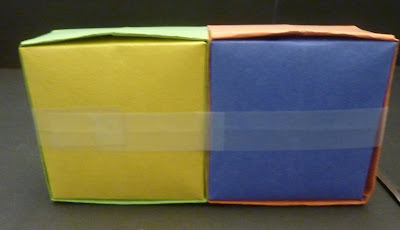After that project, I have a general rule of spending two to three hours to try it out, and if it doesn't work, I go on to another. Well, this one, I tried building a prototype with my daughter, and it went very well. I'm definitely going to use this project in the classroom this fall.
 |
| Prototype my daughter and I built the other day. |
Supplies Needed:
- Balloon
- Rubber bands
- Straws
- Thin bamboo chopsticks (skewers, lollipop stick, etc. will work, too)
- Ruler
- Scotch tape
- Masking tape
- ~2" diameter circle maker
- A piece of cardstock paper
- Small screwdriver or awl
- Something to cut chopsticks
- Scissors
Project Instructions:
- Step 1 - Tape together the two boxes from the Part 1 of this project and set them aside.
- Step 2 - Trace and cut out the Six wheels with the holes for the axle in the center.
- Step 3 - Mark and cut three axle casings to size (~1/2" wider than the vehicle body width). An axle should freely slide in the casing.
- Step 4 - Mark and cut three axles to size (~ 1" to 1 1/2" wider than the axle casing width). An axle should slide freely in the casing.
- Step 5 - Assembling the "engine" of this vehicle.
- Insert a straw into a balloon.
- Put a rubber band around the neck of the balloon over the straw.
- Step 6 - Tape the axle casings on the bottom of the vehicle. Place rubber bands on the boxes. The orange box is the front-end of the vehicle, and the green box is the back-end of the vehicle. This rubber band configuration worked for me, but you can try others to keep the balloon and the straw in place.
- Step 7 - Put the wheels on the axle. Surprisingly, this was the most difficult part of the project - sticking/taping/sliding wheels onto the axle. I wasn't satisfied with any of the processes of keeping the wheels on the axle, but all three ways work.
In the process of building this vehicle for the blog and instructables.com, I built three.
I found it challenging to make the vehicle go straight. There were a lot of variables to consider, but the most important one is to make sure that the axle casing is taped on straight. Also, try tweaking the axle and flattening out or smoothing out wheels, but the results were mixed. I may have to tinker with this a little longer.
This project was a surprise because I expected it to take longer. But it didn't, and I was really happy with that. I could have cut out even more time by using a single serve cereal boxes or other smaller movie-sized candy boxes, but as I said, I wanted uniformity of sorts. But I'm not sure if I'm going to stick with making the boxes in classrooms because I only have 1 or 1 1/2 hours per project.
Thanks and have fun!



































